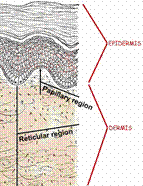The integumentary system is the skin. It has three primary functions which are to guard the body's physical and biochemical integrity, maintain a constant body temperature, and provide sensory information about the environment around them.
The skin is a big organ that is made up of all four tissue types. It is 22 square feet and 1-2 mm thick, and believe it or not, the skin is 10 pounds!
There are different parts to human skin starting with epidermis. The epidermis is the fake part of the skin and made of epithelial tissue. Within the epidermis there are four principle cells. The keratinocytes produce keratin, which helps keep the skin safe and protects underlying tissue from heat, microbes, and chemicals. It also has lamellar granules which gives off a waterproof sealant. The epidermis also includes melanocytes which make the brown pigment melanin. Langerhans' cells are also in the epidermis. These are epidermal macrophages that help start up the immune system. In the epidermis there are also Merkel cells, which function as touch receptors working with sensory nerve endings.
Layers of the Epidermis (:
Stratum Basal (Basal Layer) :
- Made of a single row of the youngest keratinocytes
- Deepest epidermal layer attached to the dermis
- The cells go through rapid division.
Stratum Spinosum (Prickly/Spiny Layer) :

- Cells are made of a weblike system of intermediate filaments that are connected to desmosomes.
- There are a lot of melanin granules and Langerhans' cells in this layer.
Stratum Granulosum (Granular Layer) :
- Very thin, 3-5 layers which big changes in keratinocyte appearance happens.
- Keratohyaline and lamellated granules gather in this layer of cells.
Stratum Lucidum (Clear Layer) :
- Very thin, see-through band that is superficial to the stratum granulosum
- Made of a few rows of flat, dead keratinocytes
- Only found in think skin.
Stratum Corneum (Horny Layer) :
- Keratinized cells
- Responsible for 3/4 of the epidermal thickness
- 3 different functions which include:
- Waterproof
- Protects against abrasions and penetration
- Helping the body closely insensitive to biological, chemical, and physical attacks.
What is the dermis?
The dermis is the 2nd major skin region which is made of strong, flexible connective tissue. The cell types include fibroblasts, macrophages, and sometimes mast cells and white blood cells.
Layers of the DERMIS =)
PAPILLARY LAYER :)
- The layer is made with areolar connective tissue with collagen and elastic fibers
- Its major surface contains peg like projections called dermal papillae
- Dermal papillae is made with capillary loops, Meissner's corpuscles, and free nerve endings!
RETICULAR LAYER (:
- This layer is responsible for about 80% of the skins thickness.
- The layers of collagen in this layer make the skin stronger and more resilient.
- The elastin fibers provide stretch-recoil properties.
Last but not least is the hypodermis. It is the subcutaneous layer which is deep to the skin. It is made of adipose and areolar connective tissue.
Resource!


No comments:
Post a Comment